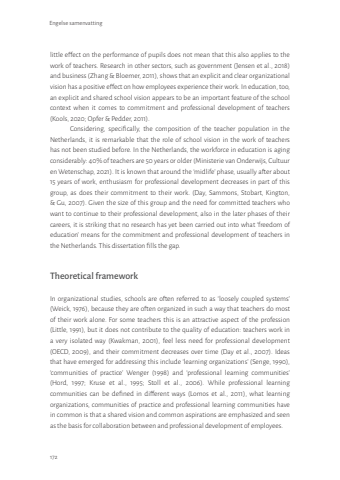Page 174 - Demo
P. 174
Engelse samenvatting172little effect on the performance of pupils does not mean that this also applies to the work of teachers. Research in other sectors, such as government (Jensen et al., 2018) and business (Zhang & Bloemer, 2011), shows that an explicit and clear organizational vision has a positive effect on how employees experience their work. In education, too, an explicit and shared school vision appears to be an important feature of the school context when it comes to commitment and professional development of teachers (Kools, 2020; Opfer & Pedder, 2011).Considering, specifically, the composition of the teacher population in the Netherlands, it is remarkable that the role of school vision in the work of teachers has not been studied before. In the Netherlands, the workforce in education is aging considerably: 40% of teachers are 50 years or older (Ministerie van Onderwijs, Cultuur en Wetenschap, 2021). It is known that around the ‘midlife’ phase, usually after about 15 years of work, enthusiasm for professional development decreases in part of this group, as does their commitment to their work. (Day, Sammons, Stobart, Kington, & Gu, 2007). Given the size of this group and the need for committed teachers who want to continue to their professional development, also in the later phases of their careers, it is striking that no research has yet been carried out into what ‘freedom of education’ means for the commitment and professional development of teachers in the Netherlands. This dissertation fills the gap.Theoretical frameworkIn organizational studies, schools are often referred to as ‘loosely coupled systems’ (Weick, 1976), because they are often organized in such a way that teachers do most of their work alone. For some teachers this is an attractive aspect of the profession (Little, 1991), but it does not contribute to the quality of education: teachers work in a very isolated way (Kwakman, 2001), feel less need for professional development (OECD, 2009), and their commitment decreases over time (Day et al., 2007). Ideas that have emerged for addressing this include ‘learning organizations’ (Senge, 1990), ‘communities of practice’ Wenger (1998) and ‘professional learning communities’ (Hord, 1997; Kruse et al., 1995; Stoll et al., 2006). While professional learning communities can be defined in different ways (Lomos et al., 2011), what learning organizations, communities of practice and professional learning communities have in common is that a shared vision and common aspirations are emphasized and seen as the basis for collaboration between and professional development of employees.Ester Moraal.indd 172 22-09-2023 16:13


